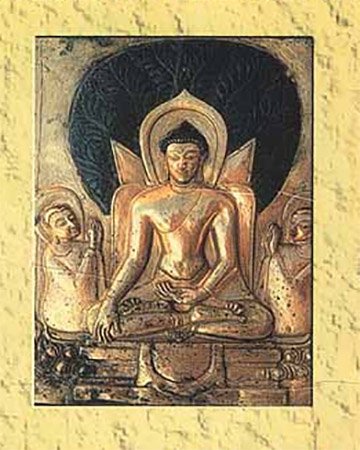The Mahavastu (great story)
by J. J. Jones | 1949 | 502,133 words | ISBN-10: 086013041X
This page describes higher deva realms which is Chapter III-f of the English translation of the Mahavastu (“great story”), dating to the 2nd-century BC. This work belongs to the Mahasanghika school of early Buddhism and contains narrative stories of the Buddha’s former lives, such as Apadanas, Jatakas and more..
Chapter III-f - Visit to other worlds (6): Higher Deva Realms
The venerable Mahā-Maudgalyāyana often went on visits to the Yāma[1] devas, the Tuṣita[2] devas, the Nirmāṇarati[3] devas, the Paranirmitavaśavartin[4] devas, and the devas of the Brahmā worlds including the Śuddhāvāsa[5] devas. He saw the Śuddhāvāsa devas, how they are virtuous, mighty, long-lived, beautiful, and enjoying great well-being. They are self-luminous, travel through the air, have pleasant food, live happily, and go wheresoever they wish. They are free from passion. They are deva arhans who win release in the middle of their sojourn in heaven,[6] are not subject to return to this world,[7] and are free from all association with the ignorant and average worldling.[8]
When the elder had seen all this prosperity of the devas, he came to the Jeta Grove, and described it at length to the four assemblies. “Thus,” said he, “do beings, as a maturing of their good karma, attain the bliss of devas among the devas. But this, too, is impermanent, and liable to sorrow and change.
The whole world is fraught with peril. The whole world is on fire; the whole world is ablaze. The whole world is quaking.
But the dharma which the Buddhas preach for the attainment of the ultimate goal, and which is not practised by the average worldling,[9] is immovable and unshakeable.
Therefore we must strive after knowledge, win it, be enlightened, be fully enlightened, perform the right deed, live the holy life, and commit no sin in this world. Thus I declare.”
When they had heard the elder, many thousands of beings, devas and men, won immortality.
Footnotes and references:
[1]:
A class of devas ranking between the Trāyastriṃśa and the Tuṣita devas. The Commentaries explain the name as meaning “ having attained divine bliss," or “ freed from misery ” or “ governing devas ” (√yam). They have also been taken to be the “ devas of Yama’s realm.”
[2]:
See above p. 4.
[3]:
Devas inhabiting the fifth of the six deva-worlds. The name means “delighting in their own creations.”
[4]:
Devas inhabiting the highest stage of the sensuous universe. Their name is interpreted as meaning “those who have power over the creations of others.”
[5]:
Or, the devas of the “ Pure Abodes,” a name given to a group of Brahma-worlds consisting, in the Pali form of their names, of Avihā, Atappā, Sudassā, Sudassī, and Akaniṭṭhā.
[6]:
Antarāparinirvāyī, Pali antarāparinibbāyin, e.g., D. 3. 237.
[7]:
Anāvartikadharmā asmiṃ loke.
[8]:
Pṛthagjana = Pali puthujjana, which obviously is derived from Pali puthu = pṛthak, “separate,” “individual," but, in sense, is taken as though it were from puthu = pṛthu, “wide,” “numerous,” i.e. the “many-folk."
[9]:
The Pali parallel to these gāthās is to be found at S. 1. 133, following which, the confessedly difficult reading sapṛthagjanasevitam of Senart’s text has been changed into apṛthagjanasevitam, “not by the worldling practised.”
